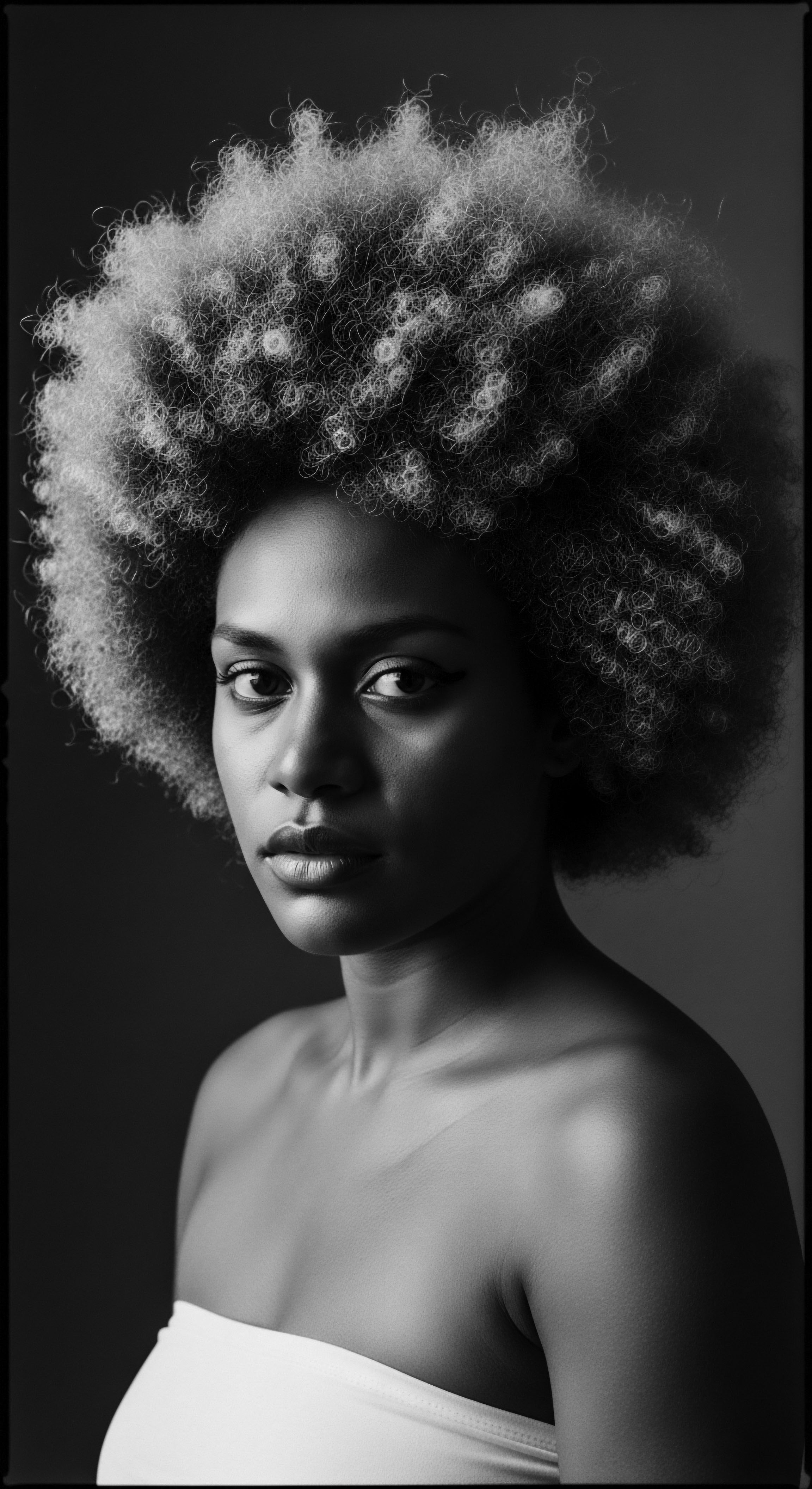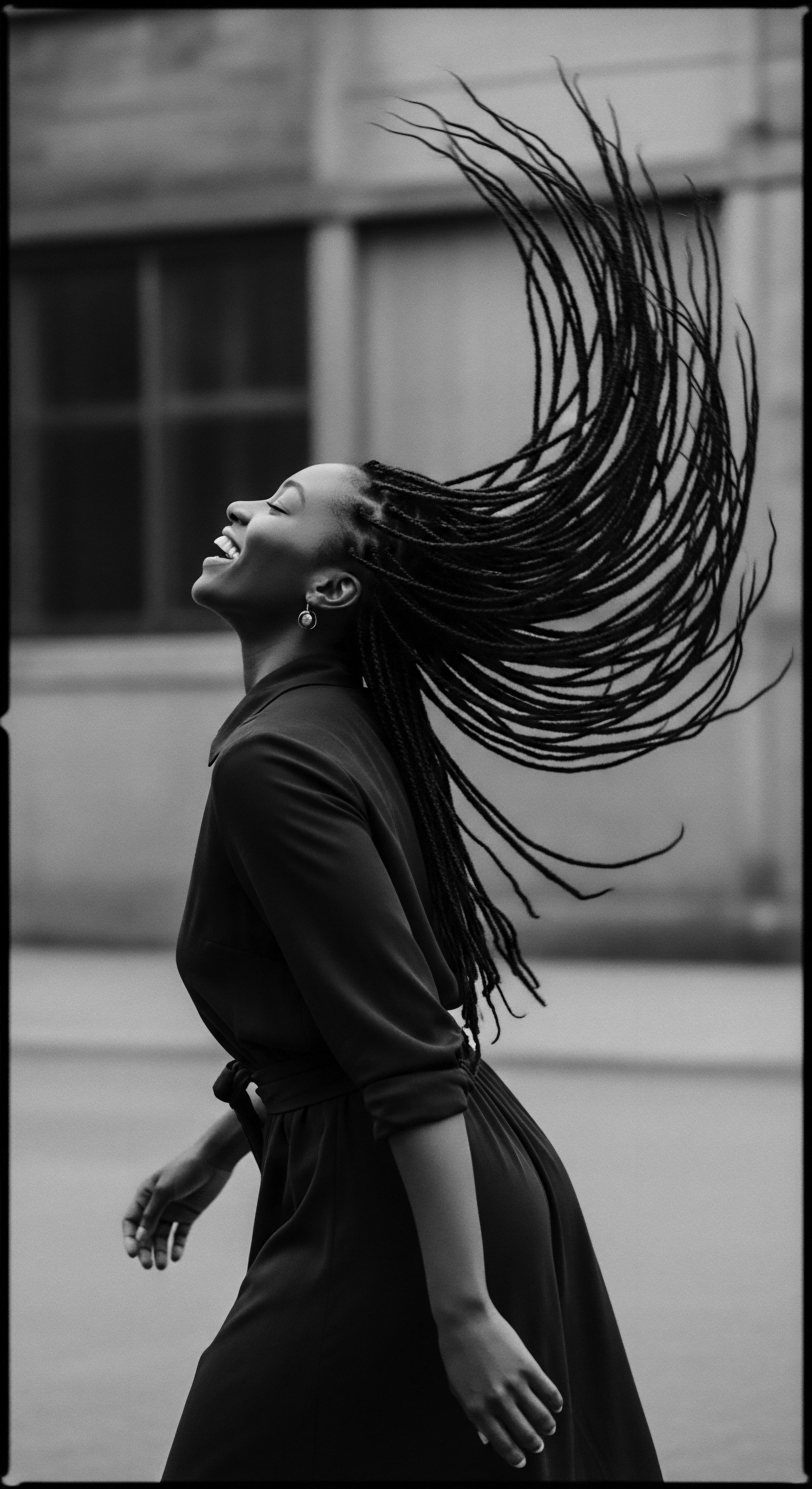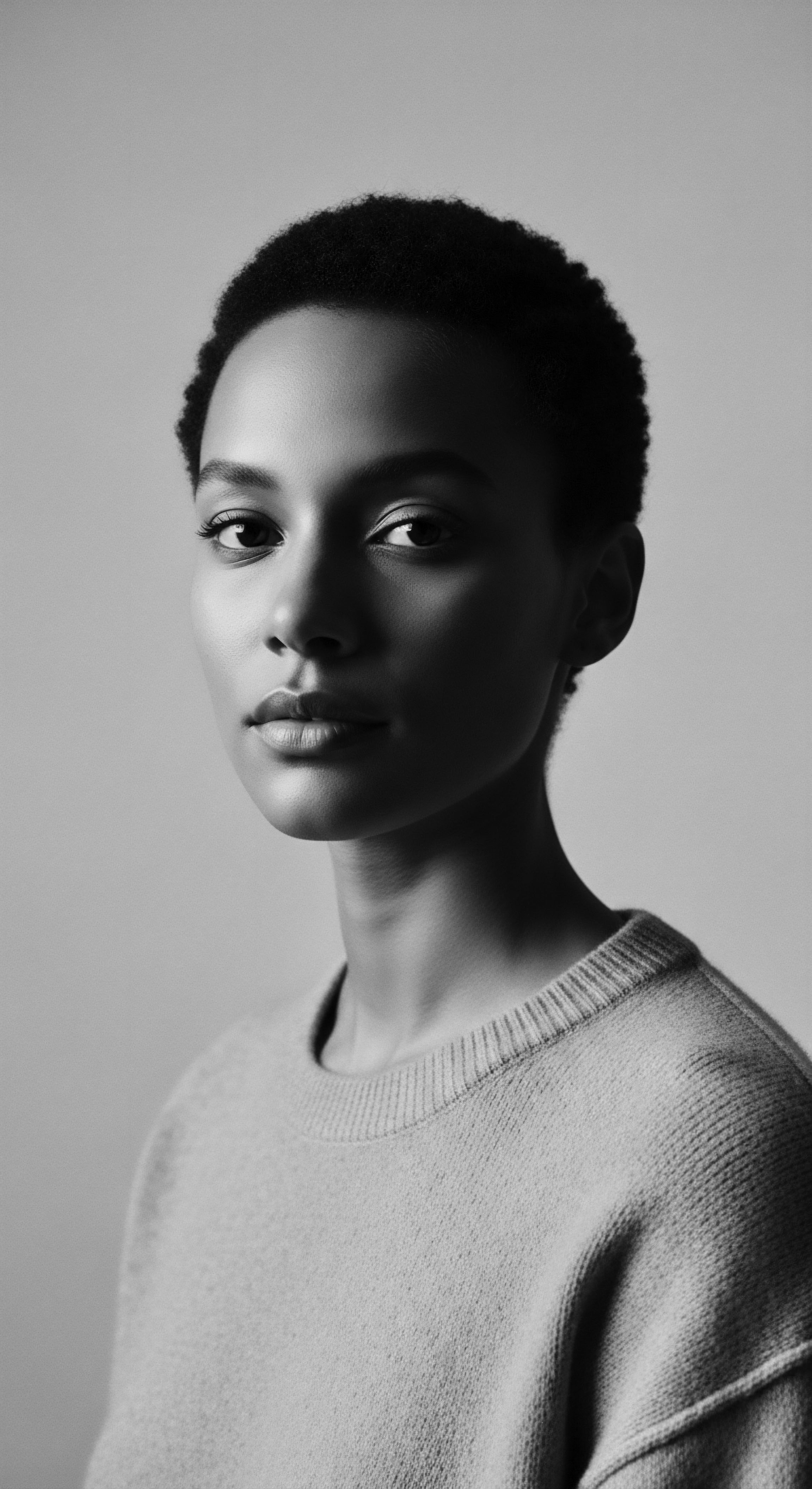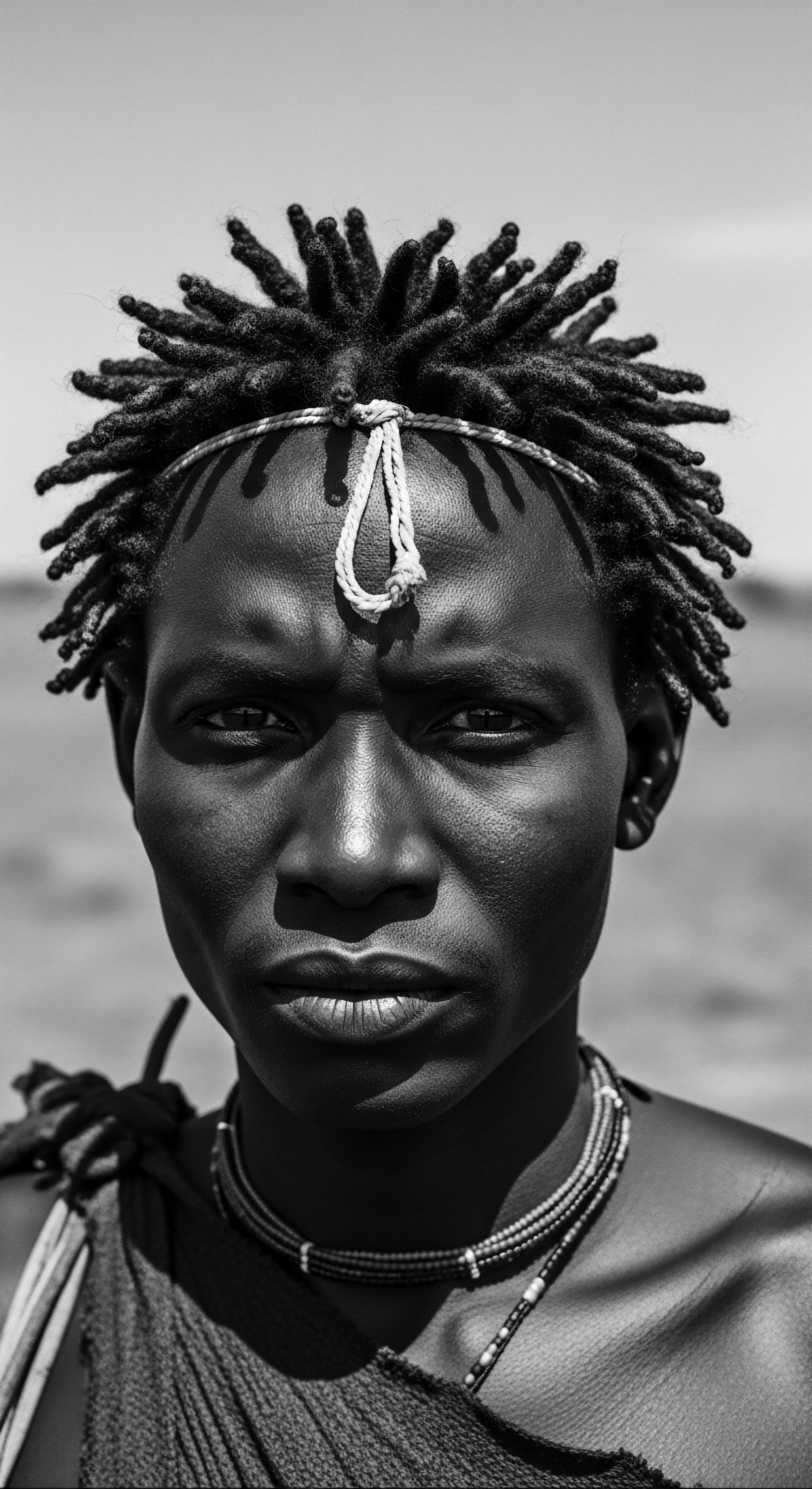
Roots
To journey into the heart of contemporary Black hair movements is to step onto ancestral ground, to feel the gentle pull of lineage. It is to trace an invisible, yet profoundly felt, thread connecting past to present, where each curl, every coil, and every wave whispers stories of resilience, artistry, and an inherited wisdom that has shaped identity across centuries. For those of us rooted in Black and mixed-race experiences, hair extends beyond simple adornment.
It stands as a living testament to journeys undertaken, trials met, and cultural legacies maintained. The hair on one’s head, in its organic unfolding, holds secrets of biological heritage, a unique architecture sculpted by generations.
Consider, for a moment, the fundamental biology that underpins this rich heritage. Textured hair, whether tightly coiled, spiraled, or wavy, possesses a distinct anatomical structure. The hair shaft, rather than forming a perfectly circular shape, takes on an elliptical or flattened cross-section. This unique geometry, coupled with the way keratin proteins assemble, creates bends and twists along the strand.
These twists, while lending hair its extraordinary visual character and volume, also contribute to its particular needs in terms of moisture retention and tensile strength. The follicle, the tiny organ beneath the scalp responsible for hair growth, plays a pivotal role here, often curving significantly beneath the skin, guiding the helical path of the strand as it emerges. This elemental biology, passed down through the ages, is the very source from which our hair heritage springs.
Textured hair, a living archive, carries the imprints of elemental biology and ancestral wisdom within its very structure.
Long before the scientific lens dissected the helix, ancestral communities possessed an intuitive, profound understanding of hair’s capabilities. Ancient African societies revered hair not merely as a biological appendage, but as a direct channel to the divine, a spiritual conduit. The head, regarded as the highest point of the body, was a sacred space, a nexus of ancestral energy and personal power.
Hair, therefore, became a powerful medium for communication, a visible language telling tales of a person’s familial lineage, social status, age, marital standing, or even their spiritual alignment. This understanding meant that hair care was never a mundane task; it was a ritual, a communal gathering, a moment of deep connection.

Understanding Textured Hair’s Ancestral Form
The earliest classifications of hair, predating modern typology, were born from lived experience and cultural observation. They centered on the hair’s behavior, its capacity for intricate styling, and its response to natural elements. There wasn’t a universal, rigid numerical system; instead, communities understood the nuanced variations within their own populations. Different regions, tribes, and families developed specific methods and approaches to hair cultivation based on its inherent characteristics, a testament to empirical knowledge refined over generations.
- Coil ❉ Often referencing hair that forms small, tight spirals, akin to the winding of a spring. This characteristic historically influenced elaborate updos and intricate braiding styles, allowing for voluminous forms.
- Kink ❉ Describing sharp, angular bends along the hair strand, which could interlock with neighboring strands to create a dense, resilient mass. This texture was particularly suited for styles that prioritized structure and longevity, like tightly woven cornrows.
- Thread ❉ A term sometimes used metaphorically or literally, referring to the practice of wrapping hair with fibers or extensions, a technique with roots in ancient Egypt and various West African cultures, which served both protective and artistic ends.
The hair growth cycle, a seemingly universal biological process, was also observed through an ancestral lens. While modern science details anagen, catagen, and telogen phases, traditional societies understood the ebb and flow of hair’s life, its seasons of growth and shedding. This knowledge informed practices of seasonal cleansing, deep conditioning with natural oils, and protective styling during periods of perceived vulnerability. Environmental factors—the sun’s intensity, the arid winds, the abundance of local flora—all shaped these practices, intertwining human care with the rhythms of the earth.
| Aspect of Hair Hair's Nature |
| Ancestral Perspective (Pre-Colonial) Spiritual conduit, identity marker, social language. |
| Contemporary Scientific Perspective Protein fiber, anatomical structure, genetic expression. |
| Aspect of Hair Classification |
| Ancestral Perspective (Pre-Colonial) Based on feel, visual pattern, styling potential; local terms. |
| Contemporary Scientific Perspective Numerical types (e.g. 4C, 3A), microscopic structure, curl pattern. |
| Aspect of Hair Care Philosophy |
| Ancestral Perspective (Pre-Colonial) Holistic well-being, communal ritual, natural resource use. |
| Contemporary Scientific Perspective Molecular interactions, ingredient chemistry, targeted solutions. |
| Aspect of Hair Hair Health |
| Ancestral Perspective (Pre-Colonial) Nourishment from earth, protective measures, spiritual balance. |
| Contemporary Scientific Perspective Hydration, protein balance, scalp microbiome, genetic predisposition. |
| Aspect of Hair The deep respect for hair's inherent characteristics and its role in human connection has remained a constant across time, unifying diverse approaches to textured hair care. |
The very lexicon surrounding textured hair has evolved, yet some ancestral terms retain a profound resonance. Words once used to describe a particular twist or coil in an African village find echoes in modern discourse, highlighting the enduring nature of our observations. The reverence for hair’s natural state, often expressed through elaborate braiding and coiling, persisted even through periods of immense hardship, a testament to the profound connection between self and strand.

Ritual
The meticulous choreography of styling textured hair stands as a profound inheritance, a living library of techniques passed through generations. It is here, in the tender manipulation of strands, that the spirit of Black hair heritage manifests most vibrantly. From ancient West African communities where intricate coiffures communicated social standing and spiritual beliefs, to the modern-day salon or bathroom mirror, the act of styling is a conversation with history, a continuity of ancestral practice. The contemporary movements celebrating natural textures are not simply aesthetic choices; they are powerful affirmations of self, rooted deeply in the enduring artistry of the past.
The protective styling choices so prevalent today bear a direct lineage to ancient methods of preserving hair and communicating identity. Consider the various forms of braids, twists, and locs; each a testament to an ingenuity born of necessity and artistic vision. In pre-colonial Africa, such styles were far more than decorative. They signified rites of passage, marital status, or even one’s role within a community (Byrd and Tharps, 2001).
The Yoruba people of Nigeria, for instance, crafted elaborate designs to honor ceremonial and spiritual occasions, while the Himba tribe in Namibia wore dreadlocked styles coated with red ochre paste, symbolizing their connection to the earth and their ancestors. This deeply rooted historical practice continues today. Modern adaptations of these ancestral styles, like box braids, cornrows, and faux locs, serve a dual purpose ❉ they shield delicate strands from environmental stressors, supporting hair health, while also providing a canvas for personal expression and cultural pride.
Contemporary protective styles carry the echoes of ancient African ingenuity, blending hair health with cultural narrative.

How Do Ancestral Styling Methods Inform Current Protective Styling?
The foundation of protective styling lies in minimizing manipulation and promoting moisture retention, principles understood and practiced for centuries. Many contemporary methods can trace their origins to these deep ancestral roots.
- Braiding ❉ The art of interlocking three or more sections of hair. Its origins in African culture extend back thousands of years, with archaeological evidence pointing to its widespread practice as early as 3500 BC. Traditional uses included signifying tribe, social status, and family background. Contemporary styles like knotless braids and cornrows extend this legacy, offering both versatility and protection.
- Twisting ❉ Involves coiling two strands of hair around each other. This simpler, often quicker method has ancient roots, used to create compact, low-maintenance styles that safeguarded hair. Modern twists, including Senegalese twists and Marley twists, continue this tradition of minimal stress on the hair shaft.
- Locing ❉ The natural coiling and compression of hair strands into rope-like segments. Dreadlocks, as they are commonly known, have a long and sacred history in many African spiritual traditions, dating back to 500 BCE among the Ethiopian Coptic Orthodox Church. The practice today, from freeform locs to manicured styles, remains a powerful statement of identity, spiritual connection, and rebellion against conventional beauty standards.
The tools of styling, too, have evolved while maintaining a connection to their heritage. What began as simple, hand-carved wooden combs, often adorned with symbolic carvings, or natural fibers for extensions, has transformed into a diverse array of brushes, picks, and synthetic materials. Yet, the essence remains. The specialized afro pick, a modern iteration of ancient tools, helps detangle and shape voluminous textures with a gentleness necessary to preserve delicate curls, a testament to the ongoing demand for tools suited to our unique hair.

Are Traditional Hair Tools Still Relevant Today?
Indeed, the relevance of traditional hair tools persists, often influencing the design and application of modern implements. The ancestral understanding of how to treat and sculpt textured hair laid the groundwork for today’s toolkit.
- Combs ❉ Hand-carved wooden combs, some dating back millennia, were art pieces themselves, used not just for detangling but for parting hair and aiding in intricate style creation. Their broad teeth and smooth surfaces minimized breakage. Modern wide-tooth combs directly echo this design philosophy, prioritizing gentle detangling over harsh pulling.
- Fibers ❉ Natural fibers, like sisal, raffia, or even cotton, were historically used to add length and volume, or to create protective wraps. These early extensions were often blended seamlessly with natural hair, showcasing a sophisticated understanding of hair manipulation. Contemporary wigs and hair extensions, though often synthetic or human hair, continue this legacy of transformative styling.
- Adornments ❉ Beads, cowrie shells, gold, and other natural elements were woven into hairstyles to denote status, communicate messages, or simply celebrate beauty. This practice continues globally, with modern styling often incorporating metal cuffs, colorful beads, or intricate wraps, connecting present-day aesthetics to ancient ceremonial and celebratory expressions.
Even heat styling, often seen as a contemporary imposition, has historical parallels, albeit with far less intensity. Some historical accounts point to the use of heated implements or specialized methods to straighten or mold hair, though these were rudimentary and likely less damaging than modern tools. Today, the prevalence of flat irons and curling wands necessitates a strong emphasis on thermal protection, a recognition of the delicate balance required to achieve desired styles without compromising the strand’s integrity. The journey from ancient transformative styling to modern techniques reflects a continuous quest for expression, an unbound helix of creativity shaped by heritage.

Relay
The current wave of hair movements, particularly those celebrating natural textured hair, forms a vital continuum in the enduring spirit of Black hair heritage. This modern awakening is not a fleeting trend; it stands as a profound reclamation, a collective stride towards self-acceptance and a deeper connection to ancestral wisdom. It is a nuanced response to historical pressures and a contemporary re-assertion of identity, drawing upon centuries of inherited knowledge about hair care, community, and expression.
The natural hair movement, which gained significant traction in the early 2000s and continues to evolve, represents a deliberate departure from Eurocentric beauty standards that historically promoted chemical alteration for straight hair. This movement encourages Black women to abandon toxic chemical straighteners, championing healthier care practices and redefining beauty ideals rooted in African heritage. This echoes the “Black is Beautiful” sentiment of the 1960s, a powerful cultural shift that promoted the Afro as a symbol of resistance and pride.
The connection between present-day natural hair advocacy and ancestral practices is evident in the holistic approach many now adopt for their hair care. This approach often prioritizes natural ingredients and a gentle, nourishing regimen, reflecting the traditional reliance on earth’s bounty for hair vitality.

What Is The Role of Nighttime Rituals In Preserving Hair Health?
Nighttime care, a cornerstone of contemporary healthy hair regimens, carries deep historical resonance. The use of protective coverings, like bonnets and wraps, stretches back generations, embodying an ancestral understanding of preservation. In many African cultures, head coverings were not only practical shields against dust and sun but also symbols of status, marital standing, or mourning. Today, the widespread use of satin or silk bonnets and pillowcases represents a modern adaptation of this wisdom.
These accessories serve a critical function ❉ minimizing friction between hair strands and abrasive fabrics, thereby preserving moisture, reducing breakage, and maintaining styling. The careful preparation of hair before rest, whether through gentle detangling, twisting, or braiding, extends the life of a style and protects delicate ends, echoing ancestral practices of safeguarding hair’s health.
The meticulous attention to ingredients also connects modern care to ancestral wisdom. Traditional African societies utilized a rich array of natural ingredients for hair health, passed down through oral traditions and communal practices. Shea butter, sourced from the karite tree, was revered for its moisturizing and healing properties. Various plant oils, herbs, and clays were also used to cleanse, condition, and strengthen hair.
These practices, born of necessity and deep ecological understanding, laid the groundwork for today’s ingredient-conscious consumer. Many contemporary hair products now actively incorporate these very ingredients, validating ancient knowledge with modern scientific understanding. The cyclical return to these heritage ingredients highlights a universal truth about what truly nourishes textured hair.
One poignant historical example that powerfully illuminates the enduring spirit of Black hair heritage is the practice of hair discrimination, and the contemporary legislative responses to it. For centuries, across the diaspora, Black hair has been targeted and denigrated, weaponized to create caste systems during enslavement, where individuals with kinky hair were relegated to arduous manual labor, while those with straighter textures were sometimes granted “privilege” in domestic roles. This systemic prejudice continues to manifest in modern workplaces and schools. A 2023 CROWN Workplace Research Study, co-commissioned by Dove and LinkedIn, revealed that Black women’s hair is 2.5 times more likely to be perceived as unprofessional, and approximately two-thirds (66%) of Black women change their hair for a job interview.
This statistic speaks volumes about the enduring societal pressure to conform to Eurocentric beauty norms. However, contemporary movements reflect this enduring spirit through the CROWN Act (Creating a Respectful and Open World for Natural Hair), which seeks to legally protect against discrimination based on race-based hairstyles, including braids, locs, twists, and knots. First passed in California in 2019, this legislation now exists in various forms across many U.S. states and municipalities, representing a powerful, collective fight to reclaim and safeguard the right to wear one’s hair in its natural, ancestral forms.
The CROWN Act stands as a contemporary testament to the enduring fight against hair discrimination, a battle rooted in ancestral resilience.

How Do Contemporary Movements Address Historical Hair Trauma?
Addressing hair trauma, an inherited burden for many in the Black community, is a core aspect of contemporary hair movements. This trauma stems from centuries of policing, devaluing, and misrepresenting textured hair. The response today involves multiple layers of healing and affirmation.
- Self-Acceptance ❉ Moving away from chemically straightened hair marks a powerful act of self-acceptance, valuing the natural curl pattern as inherently beautiful and professional. This internal shift challenges imposed beauty standards and aligns with the ancestral reverence for hair’s authentic form.
- Education ❉ A renewed focus on understanding textured hair biology and care practices, often shared through digital communities and specialized salons, counters generations of misinformation and neglect. This knowledge empowers individuals to properly care for their hair, fostering health and growth.
- Advocacy ❉ Legislative efforts, such as the CROWN Act, directly confront systemic discrimination. These legal protections create safer spaces for individuals to wear their natural hair in schools and workplaces, dismantling barriers that historically limited opportunities based on hair texture.
Problem-solving within the textured hair community often marries ancestral solutions with modern scientific understanding. For instance, addressing dryness, a common challenge for textured hair, might involve deep conditioning with unrefined shea butter—an ingredient celebrated for centuries—combined with modern humectants to seal in moisture. Similarly, concerns about breakage might lead to a regimen emphasizing protective styles, a technique refined over generations, alongside protein treatments informed by trichological science. This synthesis of knowledge underscores the living, evolving nature of Black hair heritage, constantly adapting, innovating, and affirming itself in the present.

Reflection
To consider the enduring spirit of Black hair heritage, as seen through the lens of contemporary movements, is to witness a magnificent, continuous unfolding. Our strands are far more than protein filaments; they are living libraries, each coil holding generations of wisdom, struggle, and jubilant celebration. From the elemental biology that shapes each helix, an inheritance from the very source, to the tender, communal rituals of care, and now, the unbound expressions of identity and future-shaping, the journey of textured hair reveals a profound, unbreakable connection to ancestral narratives.
The current re-emergence of natural hair as a dominant force stands as a powerful echo from the past, a vibrant testament to resilience. It is a collective whisper from those who braided secrets into their hair to survive journeys, from those who used styles to denote status, and from those who found selfhood in the face of oppression. Today, in every proud display of an Afro, every artfully crafted braid, and every gracefully maintained set of locs, we perceive a living continuity of tradition, a dialogue with our forebears.
This deep regard for heritage, this unwavering commitment to honoring the innate beauty of textured hair, moves beyond fleeting aesthetics. It settles into the soul, reminding us that care for our hair is care for ourselves, and for the legacies that empower us to step forward, crowned in our own unique, glorious history.

References
- Akanmori, M. S. (2015). Hair styling and the significance attached to this practice have played an important role in the African traditional culture. University of Education, Winneba.
- Byrd, A. & Tharps, L. (2001). Hair Story ❉ Untangling the Roots of Black Hair in America. St. Martin’s Publishing Group.
- Harris, C. & Davis, D. R. (2023). Wear Your CROWN ❉ How Racial Hair Discrimination Impacts the Career Advancement of Black Women in Corporate America. Journal of Business Diversity, 23(2).
- Mbilishaka, A. M. (2024). Don’t Get It Twisted ❉ Untangling the Psychology of Hair Discrimination Within Black Communities. American Psychological Association.
- Sieber, R. & Herreman, F. (2000). Hair in African Art and Culture. The Museum for African Art and Prestel.
- The CROWN Act. (2023). 2023 CROWN Workplace Research Study.
